|
|
|

|
|
2009 (vol. 9)
|
|
Article 10 [2009]: The Gargasian of Gargas (Vaucluse, SE France): Synthesis of field data and revision of the foraminiferal and ostracodal microfauna, by Michel MOULLADE, Guy TRONCHETTI & Jean-François BABINOT.-
Format [HTML] or [PDF
975 KB]
Reference: [CG2009_A10]
DOI: 10.4267/2042/30051
Lang.:
|
|
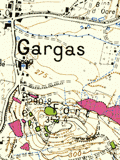 Abstract: Because of urbanization the section at Gargas, historical stratotype of the Aptian stage and of the Gargasian substage, is no longer accessible. However, samples taken there in 1966 by one of us make feasible a reinterpretation of this series in the light of taxonomic and biostratigraphic data from a recent study of Aptian microfaunas from La Tuilière area, some 5 km away. Abstract: Because of urbanization the section at Gargas, historical stratotype of the Aptian stage and of the Gargasian substage, is no longer accessible. However, samples taken there in 1966 by one of us make feasible a reinterpretation of this series in the light of taxonomic and biostratigraphic data from a recent study of Aptian microfaunas from La Tuilière area, some 5 km away.
This new micropaleontologic interpretation shows that the historical section is truncated at its base : the lower (not lowermost) Gargasian is in quasi-direct contact with Urgonian limestones ; the uppermost (marly) Bedoulian, known to be present westward towards Le Chêne as well as at La Tuilière, is absent in the stratotype outcrop. In the samples from the stratotypic succession we have identified (bottom upward):
• the upper part of the Praehedbergella luterbacheri zone and the Globigerinelloides ferreolensis zone,
• the G. barri zone,
• the beginning of the G. algerianus zone,
i.e. these zones comprise the major part of the lower Gargasian, the middle Gargasian and the transition to the upper Gargasian.
The upper part of the G. barri zone and the passage to the G. algerianus zone are in sandy marls of which the upper terms were said to have yielded ammonites of the
"Clansayes horizon" (sensu ante). The microfauna does not resolve this apparent discrepancy, for its state of preservation degrades rapidly in the detrital levels, to the point of quasi-disappearance in sands overlying the Clansayesian auct. A comparison with the sector of Banon, only some 10 km away, led us to suggest that these sands cropping out at top of the Gargas Hill might be of
Late Albian-Vraconnian age.
|
|
Online since December 31, 2009
|
|
Article 9 [2009]: Size variations of the vestibula of Krithe gnoma Do Carmo & Sanguinetti, 1999 (Ostracoda): a new procedure for their analysis, by Dermeval Aparecido D0 CARMO, Ricardo Piazza MEIRELES, Paulo Anselmo Ziani SUAREZ & Vinicius Moreira MELLO.-
Format [HTML] or [PDF
895 KB]
Reference: [CG2009_A09]
DOI: 10.4267/2042/30050
Lang.:
|
|
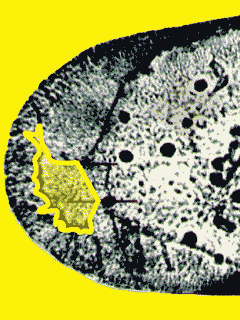 Abstract: The species Krithe gnoma was described from Holocene sediments
on the continental margin of Brazil, where it occurs on both shelf and slope. The shelf distribution of this species is restricted to
those areas influenced by the Malvinas current between 32°11' and
22°31'S. K. gnoma was selected due to the excellent resolution
of images of the anterior vestibule. So the range in size of the vestibula of
this species was used to determine whether or not the dimensions of the anterior
vestibule were to some degree related to amount of dissolved oxygen in the water at the
sampling site. Female valves of the 7th and 8th instars were measured and their sizes and those of the anterior vestibule
were compared. These valves and the reference carapace were collected at six
localities in the southern shelf area. The anterior vestibule of right and left valves of the 7th instar
and one of the 8th instar from discrete localities were measured. In the
reference carapace, the larger left valve also has the larger vestibule. A
gerontic 8th instar has valves larger than those of the previous instars, but
its vestibula are smaller than those of the 7th instar. The vestibula of the left valves of the 7th
instar collected at discrete localities showed consistent differences in size
related to the oxygen content of the sampling site. The relationship between vestibule size and oxygen
content is inversely proportional.However, the poor correlation factor (R2<<1) of these results are not
precise enough to support Peypouquet's hypothesis.
But the size of the vestibula of K. gnoma does show some degree of
relationship to oxygen content. So it is important to measure the vestibula of species of Krithe
using the procedure described here. Rigorous application of this procedure will
eliminate the possibility of discrimination based on variations in size due to ontogeny and dimorphism
leaving only those related to actual valve size. In any case, variations in the size of vestibula may have a phenotypic origin. Abstract: The species Krithe gnoma was described from Holocene sediments
on the continental margin of Brazil, where it occurs on both shelf and slope. The shelf distribution of this species is restricted to
those areas influenced by the Malvinas current between 32°11' and
22°31'S. K. gnoma was selected due to the excellent resolution
of images of the anterior vestibule. So the range in size of the vestibula of
this species was used to determine whether or not the dimensions of the anterior
vestibule were to some degree related to amount of dissolved oxygen in the water at the
sampling site. Female valves of the 7th and 8th instars were measured and their sizes and those of the anterior vestibule
were compared. These valves and the reference carapace were collected at six
localities in the southern shelf area. The anterior vestibule of right and left valves of the 7th instar
and one of the 8th instar from discrete localities were measured. In the
reference carapace, the larger left valve also has the larger vestibule. A
gerontic 8th instar has valves larger than those of the previous instars, but
its vestibula are smaller than those of the 7th instar. The vestibula of the left valves of the 7th
instar collected at discrete localities showed consistent differences in size
related to the oxygen content of the sampling site. The relationship between vestibule size and oxygen
content is inversely proportional.However, the poor correlation factor (R2<<1) of these results are not
precise enough to support Peypouquet's hypothesis.
But the size of the vestibula of K. gnoma does show some degree of
relationship to oxygen content. So it is important to measure the vestibula of species of Krithe
using the procedure described here. Rigorous application of this procedure will
eliminate the possibility of discrimination based on variations in size due to ontogeny and dimorphism
leaving only those related to actual valve size. In any case, variations in the size of vestibula may have a phenotypic origin.
|
|
Online since December 31, 2009
|
|
Memoir
3 [2009]: New data on the Middle-Upper Jurassic - Lower Cretaceous Charophytes and Ostracods from the Moroccan Atlas, by Pierre-Olivier MOJON, Hamid HADDOUMI & André CHARRIÈRE.-
Format [HTML]
or [PDF
7,487 KB, plates with a coloured background] or [PDF
8,353 KB with black & white plates]
Reference: [CG2009_M03]
DOI: 10.4267/2042/29781
Lang.:
|
|
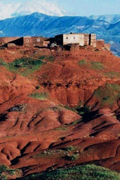 Abstract: The Middle Jurassic-Lower Cretaceous continental "Red Beds" of the Moroccan Atlas have provided very interesting new taxa of charophytes and lacustrine ostracods: Aclistochara africana n.sp. (Bathonian), Feistiella atlantis n.sp. (Hauterivian-Lower Barremian), Cypridea suprajurassica n.sp., Cypridea mohandi n.sp. and Cypridea demnatensis n.sp. (Oxfordian ? - Kimmeridgian), Harbinia atlasica n.sp. (Hauterivian ? - Lower Barremian). Micropaleontological data obtained after 2002 contributed the following: Abstract: The Middle Jurassic-Lower Cretaceous continental "Red Beds" of the Moroccan Atlas have provided very interesting new taxa of charophytes and lacustrine ostracods: Aclistochara africana n.sp. (Bathonian), Feistiella atlantis n.sp. (Hauterivian-Lower Barremian), Cypridea suprajurassica n.sp., Cypridea mohandi n.sp. and Cypridea demnatensis n.sp. (Oxfordian ? - Kimmeridgian), Harbinia atlasica n.sp. (Hauterivian ? - Lower Barremian). Micropaleontological data obtained after 2002 contributed the following:
• In the central High-Atlas, discovery of Upper Jurassic charophytes and freshwater ostracods (Dictyoclavator ramalhoi, Porochara kimmeridgensis, Aclistochara bransoni, Cypridea suprajurassica, Cypridea mohandi, Cypridea demnatensis) evince a Barremian ingression, its restricted marine character attested by lagoonal-brackish water ostracods (Harbinia atlasica) and presumed marine ostracods Trachyleberididae (cf. Strigosocythere strigosa, Cythereis ? sp., Protocythere ? sp.) associated with well-developed gypsiferous evaporites.
• In the eastern High-Atlas, charophytes have been found at levels related to the Jurassic/Cretaceous boundary (Upper Tithonian–Berriasian Porochara maxima).
• In the non-marine Lower Cretaceous (Hauterivian ? - Barremian) of the central High-Atlas, mixed Eurasian e and Gondwanian g assemblages of charophytes: Globator (e) and Feistiella (g), and brackish-lacustrine ostracods: (Fabanella-Cetacella (e), Darwinula-Cypridea-Harbinia (e & g) and Salvadoriella-Petrobrasia-Reconcavona-Paracypridea (g), were discovered.
• Complementary data for the Lower Cretaceous charophyte biozonation (Upper Valanginian-Lower Barremian interval) with Globator hemiglobatoroides Mojon n.sp. (Cenozone M7a, NE-Spain) and Globator mutabilis (Cenozone M7b) from NE-Spain and Morocco (central High-Atlas) were obtained.
• In the Moroccan Atlas area several stages in the breaking up of Pangea and the opening of the Atlantic Ocean have been recognized. These dislocations took place mainly during Bathonian times but also involved portions of the Kimmeridgian and Barremian.
|
|
Online since October 31, 2009
|
|
Article 8 [2009]: Nummulus brattenburgensis and Crania craniolaris (Brachiopoda, Craniidae), by Christian C. EMIG.-
Format [HTML] or [PDF
1.590 KB]
Reference: [CG2009_A08]
DOI: 10.4267/2042/29780
Lang.:
|
|
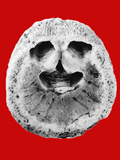 Abstract: The Brattingsborg pennies are mentioned in medieval texts dating from the middle of the first millennium and many popular medieval legends refer to their occurrence on Ivö Island in the Scania region (Sweden) as brattingsborgpenningar or in Latin as Nummulus brattenburgensis. Actually they are valves of the fossil brachiopod Crania craniolaris originally described by Linnaeus (1758) as Anomia craniolaris from the Upper Cretaceous. Later Retzius (1781) created the genus Crania based on these specimens from Ivö Island and on another species he described under Crania (now Isocrania) egnabergensis from Ignaberga in the Scania region. The scientific history of those two species is reviewed along with that of Danocrania tuberculata (Nilsson,
1826), formerly figured as Craniolites brattenburgicus, from the Danian of Scania. Two legends about these "pennies" are included. Abstract: The Brattingsborg pennies are mentioned in medieval texts dating from the middle of the first millennium and many popular medieval legends refer to their occurrence on Ivö Island in the Scania region (Sweden) as brattingsborgpenningar or in Latin as Nummulus brattenburgensis. Actually they are valves of the fossil brachiopod Crania craniolaris originally described by Linnaeus (1758) as Anomia craniolaris from the Upper Cretaceous. Later Retzius (1781) created the genus Crania based on these specimens from Ivö Island and on another species he described under Crania (now Isocrania) egnabergensis from Ignaberga in the Scania region. The scientific history of those two species is reviewed along with that of Danocrania tuberculata (Nilsson,
1826), formerly figured as Craniolites brattenburgicus, from the Danian of Scania. Two legends about these "pennies" are included.
|
|
Online since October 31, 2009
|
|
Article 7 [2009]: Quick look cathodoluminescence analyses and their impact on the interpretation of carbonate reservoirs. Case study of mid-Jurassic oolitic reservoirs in the Paris Basin, by Bruno GRANIER & Christian STAFFELBACH.-
Format [HTML] or [PDF
716 KB]
Reference: [CG2009_A07]
DOI: 10.4267/2042/28795
Lang.:
|
|
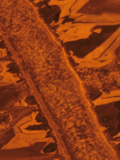 Abstract: Cathodoluminescence analyses on samples from
Middle Jurassic oolitic limestones allow us to reconstruct the diagenetic history of these oil and gas reservoirs: a succession of events starting with the early, synsedimentary
phases of marine cementation and ending with the addition of hydrocarbons to the reservoir. Constraints on the timing of events are derived from their calibration
with the chronology of the well-known regional tectonic calendar. Fracturing, due first to the post-Pyrenean extension and then to the Alpine compression, led respectively in Oligocene
times to a recharge of the aquifer and a correlative change in cementation, and in Miocene times to the addition of hydrocarbons into the same
flow units, this last event blocking diagenesis, at least in the zone above the oil-water contact. Distributions of cements and residual porosity
within sedimentary units without stratigraphic significance, called here "pseudo-parasequences", were for the most part inherited from
the original depositional facies. Abstract: Cathodoluminescence analyses on samples from
Middle Jurassic oolitic limestones allow us to reconstruct the diagenetic history of these oil and gas reservoirs: a succession of events starting with the early, synsedimentary
phases of marine cementation and ending with the addition of hydrocarbons to the reservoir. Constraints on the timing of events are derived from their calibration
with the chronology of the well-known regional tectonic calendar. Fracturing, due first to the post-Pyrenean extension and then to the Alpine compression, led respectively in Oligocene
times to a recharge of the aquifer and a correlative change in cementation, and in Miocene times to the addition of hydrocarbons into the same
flow units, this last event blocking diagenesis, at least in the zone above the oil-water contact. Distributions of cements and residual porosity
within sedimentary units without stratigraphic significance, called here "pseudo-parasequences", were for the most part inherited from
the original depositional facies.
|
|
Online since September 30, 2009
|
|
Article 6 [2009]: The Paleocene and earliest Eocene foraminiferal Family Miscellaneidae: neither nummulitids nor rotaliids, by Lukas HOTTINGER.-
Format [HTML] or [PDF
27,417 KB]
Reference: [CG2009_A06]
DOI: 10.4267/2042/28794
Lang.:
|
|
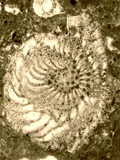 Abstract: The Miscellaneidae are divided into two groups of species: forms with a single intercameral foramen and forms with two or a row of multiple foramina. Ten taxa ascribed to this family are revised, amply illustrated and discussed considering both micro- and megalospheric
generations. The Family Miscellaneidae is assigned to the Superfamily Nonionacea by reason of their planispiral-involute coiling combined with an interiomarginal position of the foramina. Their combined range covers SBZ zones 2-5 and an area comprising the Central and Western Neotethys including the Pyrenean Gulf. They do not reach the western shores of the Atlantic. Miscellanites meandrinus and Bolkarina aksarayi exhibit extreme morphological features, respectively meandrine alar
extensions and expanse chambers. These features are of general interest for the comparative anatomy of the shells of the larger foraminifera in order to understand their biological significance. Abstract: The Miscellaneidae are divided into two groups of species: forms with a single intercameral foramen and forms with two or a row of multiple foramina. Ten taxa ascribed to this family are revised, amply illustrated and discussed considering both micro- and megalospheric
generations. The Family Miscellaneidae is assigned to the Superfamily Nonionacea by reason of their planispiral-involute coiling combined with an interiomarginal position of the foramina. Their combined range covers SBZ zones 2-5 and an area comprising the Central and Western Neotethys including the Pyrenean Gulf. They do not reach the western shores of the Atlantic. Miscellanites meandrinus and Bolkarina aksarayi exhibit extreme morphological features, respectively meandrine alar
extensions and expanse chambers. These features are of general interest for the comparative anatomy of the shells of the larger foraminifera in order to understand their biological significance.
|
|
Online since September 30, 2009
|
|
Memoir 2 [2009]: Subfamily Taramelliceratinae (Ammonitina, Haploceratoidea, Oppeliidae) from Middle and Upper Oxfordian strata (Plicatilis Zone, Vertebrale Subzone - Bimammatum Zone, Berrense Subzone) of N Vienne, France (submediterranean province), by Philippe QUEREILHAC.-
Format [HTML] or [PDF
17,578 KB]
Reference: [CG2009_M02]
DOI: 10.4267/2042/28698
Lang.:
|
|
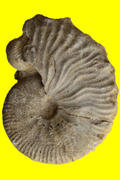 Abstract: In the area of northern Poitou studied Taramelliceratinae are present at every level except in the Schilli Subzone, itself possibly absent, and the Stenocycloides Subzone in which only Perisphinctidae and Trimarginites sp. occur. Although some species are known and cited in the literature often, they are figured infrequently or not at all: Taramelliceras (Taramelliceras) dentostriatum (Quenstedt), T. (T.) callicerum (Oppel), T. (Proscaphites) anar (Oppel). Here, the ranges of these species in the stratigraphic succession were determined through their association with other faunas in the same collections, using the presence or absence of known precise stratigraphic markers (for example: Neomorphoceras chapuisi (Oppel) = Transversarium Zone, Luciaeformis Subzone; Taramelliceras (? Taramelliceras) colleti (Lee) = Rotoides Subzone; "Epipeltoceras semimammatum" (Quenstedt) = Bimammatum Zone, "Berrense" Subzone, Semimammatum horizon) and/or the disappearance of species with longer ranges (for example: the disappearance of Neoprionoceras lautlingensis (Rollier) which is present in the Parandieri Subzone, but absent in the overlying Luciaeformis Subzone). The ranges of certain species that had been incorrectly located stratigraphically : T. (T.) dentostriatum (Quenstedt), T. (T.) callicerum (Oppel), T. (T.) externnodosum Dorn, have been restored to their true location as determined from their occurrences in the author's collections and in those of other collectors who had noted their stratigraphic relationships to other taxa. Abstract: In the area of northern Poitou studied Taramelliceratinae are present at every level except in the Schilli Subzone, itself possibly absent, and the Stenocycloides Subzone in which only Perisphinctidae and Trimarginites sp. occur. Although some species are known and cited in the literature often, they are figured infrequently or not at all: Taramelliceras (Taramelliceras) dentostriatum (Quenstedt), T. (T.) callicerum (Oppel), T. (Proscaphites) anar (Oppel). Here, the ranges of these species in the stratigraphic succession were determined through their association with other faunas in the same collections, using the presence or absence of known precise stratigraphic markers (for example: Neomorphoceras chapuisi (Oppel) = Transversarium Zone, Luciaeformis Subzone; Taramelliceras (? Taramelliceras) colleti (Lee) = Rotoides Subzone; "Epipeltoceras semimammatum" (Quenstedt) = Bimammatum Zone, "Berrense" Subzone, Semimammatum horizon) and/or the disappearance of species with longer ranges (for example: the disappearance of Neoprionoceras lautlingensis (Rollier) which is present in the Parandieri Subzone, but absent in the overlying Luciaeformis Subzone). The ranges of certain species that had been incorrectly located stratigraphically : T. (T.) dentostriatum (Quenstedt), T. (T.) callicerum (Oppel), T. (T.) externnodosum Dorn, have been restored to their true location as determined from their occurrences in the author's collections and in those of other collectors who had noted their stratigraphic relationships to other taxa.
It is recommended that the date of creation of the Luciaeformis Subzone and the Nectobrigensis, Luciaeformis and Subschilli horizons (Middle Oxfordian, Transversarium Zone) should be rectified. Currently, these are indicated as having been created in
1984. However, if the author's name, G. Melendez, is correct the date of their creation cannot have been
1984, the year in which the G. Melendez thesis was defended, for the manuscript was published only in
1989. It is also proposed that the Duongi horizon Melendez,
1989, be renamed as the Duongae horizon Melendez, 1989, because the index form, Perisphinctes (Dichotomoceras) duongi Melendez,
1989, is an ammonite species named to honor of A.N. Duong, a woman.
The study involved more than fifteen hundred individuals, all collected in the zone investigated. Only the most representative are figured here. The poor state of preservation of the ammonites (encrusted, often worn on one face, with the umbilicus not accessible) did not permit measurement (hence no table) except that of the diameter and sometimes the thickness. Previous studies of this subfamily or these species (Oppel,
1863; Quenstedt, 1887; Loriol,
1902; Lee, 1905; Dorn, 1931; Hölder,
1955) are old. References to this subfamily or its representatives in more recent works are only incidental and rarely include descriptions, drawing or photographs. The existence of many ammonites comprising homogeneous groups but without characteristics in common with known species justifies the creation of new species. Some microconchs have been definitely associated with a macroconch species. For others, a lack of material did not permit the establishment of such a direct link so they have been attached to the supposedly related species with the mention, "aff." (for "affinis"). Nevertheless, although described and figured, these forms remain in open nomenclature. There are some "groups" of ammonites with new characteristics that are here associated with a known species because the differences were not sufficient to create new ones; they are distinguished by "var." (for "variety"). There are also some that are referred to a previously known species because they were based only on a fragment (polymorphism?). In addition, in the zone studied the several taxa of this subfamily permit a relatively detailed stratigraphic breakdown because their existence is limited at a maximum to a subzone. However, an exception is the species Taramelliceras (Proscaphites) anar (Oppel,
1863) which ranges from the Antecedens Subzone through the Rotoides Subzone.
|
|
Online since September 15, 2009
|
|
Article 5 [2009]: The ammonite fauna of the 'marls with ferruginous fossils' from the Niort region, France (Lower Oxfordian, Cordatum Zone, Cordatum Subzone), by Philippe QUEREILHAC, Didier MARCHAND, Rémi JARDAT, Alain BONNOT, Dominique FORTWENGLER & Philippe COURVILLE.-
Format [HTML] or [PDF
4,284 KB]
Reference: [CG2009_A05]
DOI: 10.4267/2042/28697
Lang.:
|
|
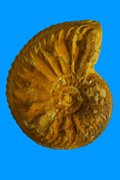 Abstract: A new collection of ammonites from the 'marls with ferruginous ammonites' in the Niort region (France), previously studied by Grossouvre
(1922), provides a large amount of biostratigraphic, paleoenvironmental and paleogeographic information. The fauna is dated Lower Oxfordian: Cordatum Zone, Cordatum Subzone, probably the lower part of it. In addition, it is unique in western Europe owing to: 1) the species found of which some appear to be known only in this deposit 2) by the extremely atypical domination of the couple Taramelliceras
- Creniceras which represent 2/3 of the specimens. Furthermore, the aspect of the fauna strongly suggests that the habitat was a distal platform unknown in other European strata of the same age. A detailed description of the several species is given, sometimes accompanied by a new taxonomic interpretation. Abstract: A new collection of ammonites from the 'marls with ferruginous ammonites' in the Niort region (France), previously studied by Grossouvre
(1922), provides a large amount of biostratigraphic, paleoenvironmental and paleogeographic information. The fauna is dated Lower Oxfordian: Cordatum Zone, Cordatum Subzone, probably the lower part of it. In addition, it is unique in western Europe owing to: 1) the species found of which some appear to be known only in this deposit 2) by the extremely atypical domination of the couple Taramelliceras
- Creniceras which represent 2/3 of the specimens. Furthermore, the aspect of the fauna strongly suggests that the habitat was a distal platform unknown in other European strata of the same age. A detailed description of the several species is given, sometimes accompanied by a new taxonomic interpretation.
|
|
Online since September 15, 2009
|
|
Letter 3 [2009]: An additional hadrosaurid specimen (Dinosauria: Ornithischia) from the marine Maastrichtian deposits of the Maastricht area, by Eric BUFFETAUT.-
Format [HTML] or [PDF
730 KB]
Reference: [CG2009_L03]
DOI: 10.4267/2042/28153
Lang.:
|
|
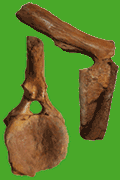 Abstract: An isolated dinosaur
vertebra from the marine deposits of the Maastrichtian type area, near the city
of Maastricht (The Netherlands), collected during the 19th century and kept in
the palaeontological collection of the Museum für Naturkunde in Berlin, is
described as a caudal vertebra of a hadrosaurid ornithopod. Although it cannot
be identified with greater accuracy, this specimen is an addition to the still
scanty, but growing, record of non-avian dinosaurs from the Maastrichtian type
area. This record is heavily dominated by hadrosaurs, which probably reflects a
real abundance of this group of dinosaurs in the late Maastrichtian of Europe. Abstract: An isolated dinosaur
vertebra from the marine deposits of the Maastrichtian type area, near the city
of Maastricht (The Netherlands), collected during the 19th century and kept in
the palaeontological collection of the Museum für Naturkunde in Berlin, is
described as a caudal vertebra of a hadrosaurid ornithopod. Although it cannot
be identified with greater accuracy, this specimen is an addition to the still
scanty, but growing, record of non-avian dinosaurs from the Maastrichtian type
area. This record is heavily dominated by hadrosaurs, which probably reflects a
real abundance of this group of dinosaurs in the late Maastrichtian of Europe.
|
|
Online since August 1, 2009
|
|
Letter 2 [2009]: Evidence of predation on the vertebra of a hadrosaurid dinosaur from the Upper Cretaceous (Campanian) of Coahuila, Mexico, by Héctor E. RIVERA-SYLVA, Eberhard FREY & José Rubén GUZMÁN-GUTIÉRREZ.-
Format [HTML] or [PDF
1,788 KB]
Reference: [CG2009_L02]
DOI: 10.4267/2042/28152
Lang.:
|
|
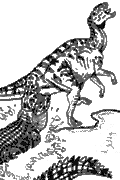 Abstract: In sediments of the
Aguja Formation (Late Cretaceous: Campanian) at La Salada in northern part of
the state of Coahuila, Mexico, numerous fossils of vertebrates have been
discovered including Hadrosauridae. One hadrosaur vertebra provides evidence of
predation probably by a giant alligator Deinosuchus riograndensis. Abstract: In sediments of the
Aguja Formation (Late Cretaceous: Campanian) at La Salada in northern part of
the state of Coahuila, Mexico, numerous fossils of vertebrates have been
discovered including Hadrosauridae. One hadrosaur vertebra provides evidence of
predation probably by a giant alligator Deinosuchus riograndensis.
|
|
Online since August 1, 2009
|
|
Article 4 [2009]: The IMAM case. Additional investigation of a micropaleontological fraud, by Bruno GRANIER, Monique FEIST, Edward HENNESSEY, Ioan BUCUR & Baba SENOWBARI-DARYAN.-
Format [HTML] or [PDF
1,916 KB]
Reference: [CG2009_A04]
DOI: 10.4267/2042/25073
Lang.:
|
|
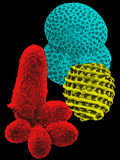 Abstract: Starting in 1996 and for almost a decade,
M.M. Imam contributed to twelve papers published in international geological journals. These papers dealt with the micropaleontology and biostratigraphy of Cretaceous to Miocene
series from Egypt and Libya. They were abundantly illustrated in order to
support the author's findings and interpretations. However most photographic
illustrations (189 at least) were fabricated with material lifted from the publications of
other authors, commonly from localities or stratigraphic intervals other than
those indicated by M.M. Imam. Abstract: Starting in 1996 and for almost a decade,
M.M. Imam contributed to twelve papers published in international geological journals. These papers dealt with the micropaleontology and biostratigraphy of Cretaceous to Miocene
series from Egypt and Libya. They were abundantly illustrated in order to
support the author's findings and interpretations. However most photographic
illustrations (189 at least) were fabricated with material lifted from the publications of
other authors, commonly from localities or stratigraphic intervals other than
those indicated by M.M. Imam.
|
|
Online since May 18, 2009
|
|
Article 3 [2009]: Uppermost Albian biostratigraphy and chronostratigraphy, by Robert W. SCOTT.-
Format [HTML] or [PDF
428 KB]
Reference: [CG2009_A03]
DOI: 10.4267/2042/24969
Lang.:
|
|
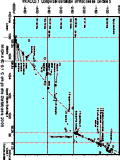 Abstract: The Albian Stage is the
highest chronostratigraphic unit of the Lower Cretaceous Series and underlies
the Cenomanian Stage of the Upper Cretaceous Series. The Albian is divided into
three substages, each of which is composed of two or three zones based on
distinctive and phylogenetically related ammonite assemblages. The uppermost
zone of the Upper Albian Substage, the Stoliczkaia dispar Zone, is found
in many Western European condensed sections. The ammonite assemblage in the thin
glauconitic sandstone near La Vraconne, Switzerland, was defined as the
'Vraconnian Stage' in 1868. However this concept has been little used and was
abandoned in 1963 as part of the Cretaceous chronostratigraphic scale. A recent
proposal to resurrect and redefine this stage is based on a number of criteria
and very detailed and reliable stratigraphic data. A quantitative
biostratigraphic analysis of the ammonite ranges in the key sections shows that
the proposed subzones of the S. dispar Zone have discordant ranges.
Furthermore, the utility of a 'Vraconnian Stage' between the Albian and
Cenomanian stages is geographically limited and the concept embraces one of many
depositional sequence cycles of the Albian. The reinstatement of a 'Vraconnian
Stage' is not recommended. Abstract: The Albian Stage is the
highest chronostratigraphic unit of the Lower Cretaceous Series and underlies
the Cenomanian Stage of the Upper Cretaceous Series. The Albian is divided into
three substages, each of which is composed of two or three zones based on
distinctive and phylogenetically related ammonite assemblages. The uppermost
zone of the Upper Albian Substage, the Stoliczkaia dispar Zone, is found
in many Western European condensed sections. The ammonite assemblage in the thin
glauconitic sandstone near La Vraconne, Switzerland, was defined as the
'Vraconnian Stage' in 1868. However this concept has been little used and was
abandoned in 1963 as part of the Cretaceous chronostratigraphic scale. A recent
proposal to resurrect and redefine this stage is based on a number of criteria
and very detailed and reliable stratigraphic data. A quantitative
biostratigraphic analysis of the ammonite ranges in the key sections shows that
the proposed subzones of the S. dispar Zone have discordant ranges.
Furthermore, the utility of a 'Vraconnian Stage' between the Albian and
Cenomanian stages is geographically limited and the concept embraces one of many
depositional sequence cycles of the Albian. The reinstatement of a 'Vraconnian
Stage' is not recommended.
|
|
Online since April 22, 2009
|
|
Article 2 [2009]: Pseudoshasticrioceras bersaci nov. sp. (Ammonoidea, Gassendiceratinae), and new ammonite biohorizon for the Upper Barremian of southeastern France, by Didier BERT & Gérard DELANOY.-
Format [HTML] or [PDF
1,7600 KB]
Reference: [CG2009_A02]
DOI: 10.4267/2042/23733
Lang.:
|
|
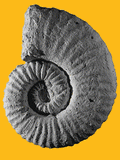 Abstract: Research in the Feraudianus Subzone of the Sartousiana Zone of the Barremian stage led to the discovery of a new species of Pseudoshasticrioceras: P. bersaci
nov. sp. Its study provides evidence concerning the developments of the latest Gassendiceratinae Bert et alii, 2006, and the relationship between the genus Pseudoshasticrioceras Delanoy, 1998, and Gassendiceras Bert et alii, 2006. In particular, this new species is derived from Pseudoshasticrioceras magnini (Delanoy, 1992) by a minor revision in the processes of ontogenesis (retardation of ornamentation -
neoteny). However, the evolution towards Pseudoshasticrioceras autrani Delanoy, 1998, implies a "failure" in this process that may possibly be related to parallel changes in environmental conditions. On the other hand, the very closely defined stratigraphic position of Pseudoshasticrioceras bersaci
nov. sp., and its position in the anagenetic lineage of Pseudoshasticrioceras, demonstrates its interest as a biostratigraphic marker: a new Bersaci Biohorizon is proposed; it is located between the Magnini and the Autrani
biohorizons. Abstract: Research in the Feraudianus Subzone of the Sartousiana Zone of the Barremian stage led to the discovery of a new species of Pseudoshasticrioceras: P. bersaci
nov. sp. Its study provides evidence concerning the developments of the latest Gassendiceratinae Bert et alii, 2006, and the relationship between the genus Pseudoshasticrioceras Delanoy, 1998, and Gassendiceras Bert et alii, 2006. In particular, this new species is derived from Pseudoshasticrioceras magnini (Delanoy, 1992) by a minor revision in the processes of ontogenesis (retardation of ornamentation -
neoteny). However, the evolution towards Pseudoshasticrioceras autrani Delanoy, 1998, implies a "failure" in this process that may possibly be related to parallel changes in environmental conditions. On the other hand, the very closely defined stratigraphic position of Pseudoshasticrioceras bersaci
nov. sp., and its position in the anagenetic lineage of Pseudoshasticrioceras, demonstrates its interest as a biostratigraphic marker: a new Bersaci Biohorizon is proposed; it is located between the Magnini and the Autrani
biohorizons.
|
|
Online since April 4, 2009
|
|
Article 1 [2009]: Albian-Middle Turonian ostracodes from the Antsiranana region (northern Madagascar): systematics, palaeoecology and palaeobiogeography, by Jean-François BABINOT, Jean-Paul COLIN & Auran RANDRIANASOLO.-
Format [HTML] or [PDF
3,284 KB]
Reference: [CG2009_A01]
DOI: 10.4267/2042/23730
Lang.:
|
|
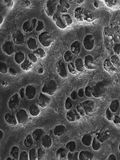 Abstract: associations from the Antsiranana region, formerly Diego-Suarez, in northern Madagascar have been studied at a taxonomic level. In the Albian-middle Turonian interval, 29 species belonging to 21 genera have been recognized, 10 new species, one new genus (Malagasyella) and a new sub-genus (Hemiglenocythere) have been erected. From a palaeoecological stand point, the succession of ostracode faunas shows a progressive shallowing trend, from basin-slope during Albian times to outer shelf during the Turonian. During these periods, the ostracode faunas of Madagascar show strong affinities with those of India (Rajasthan). This leads to a proposal for the existence of an
indo-malagasy ostracode faunal province. Abstract: associations from the Antsiranana region, formerly Diego-Suarez, in northern Madagascar have been studied at a taxonomic level. In the Albian-middle Turonian interval, 29 species belonging to 21 genera have been recognized, 10 new species, one new genus (Malagasyella) and a new sub-genus (Hemiglenocythere) have been erected. From a palaeoecological stand point, the succession of ostracode faunas shows a progressive shallowing trend, from basin-slope during Albian times to outer shelf during the Turonian. During these periods, the ostracode faunas of Madagascar show strong affinities with those of India (Rajasthan). This leads to a proposal for the existence of an
indo-malagasy ostracode faunal province.
|
|
Online since April 4, 2009
|
|
Memoir
1 [2009]: Mediterranean Neocomian belemnites, part 3: Valanginian-Hauterivian belemnites, by Nico M.M. JANSSEN.-
Format [HTML]
or [PDF
2,898 KB]
Reference: [CG2009_M01]
DOI: 10.4267/2042/23732
Lang.:
|
|
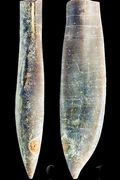 Abstract: The classical papers of Raspail
(1829, 1830) and Duval-Jouve (1841) described a wide range of belemnite
species, mainly from the Lower Cretaceous of the Castellane-Peyroules area (Alpes de
Haute-Provence, France). The present work focuses mainly on the biostratigraphy of these previously described
belemnite taxa for their stratigraphic relationships had not been determined precisely.
Here, biostratigraphy is related to the lithologic successions and faunal associations
(ammonites) of various outcrops in the area studied. Complementary data were obtained from the La
Lagne, Les Allaves and Pas d'Escale sections (Alpes de
Haute-Provence, France). And, in order to attain a better understanding of the stratigraphic distribution of
Late Valanginian belemnites in condensed glauconitic
deposits, these assemblages are compared with belemnites from deeper water successions in the Angles, Source de l'Asse de
Moriez, Cheiron areas and those in the vicinity of La Charce and Vergol that are even deeper. Abstract: The classical papers of Raspail
(1829, 1830) and Duval-Jouve (1841) described a wide range of belemnite
species, mainly from the Lower Cretaceous of the Castellane-Peyroules area (Alpes de
Haute-Provence, France). The present work focuses mainly on the biostratigraphy of these previously described
belemnite taxa for their stratigraphic relationships had not been determined precisely.
Here, biostratigraphy is related to the lithologic successions and faunal associations
(ammonites) of various outcrops in the area studied. Complementary data were obtained from the La
Lagne, Les Allaves and Pas d'Escale sections (Alpes de
Haute-Provence, France). And, in order to attain a better understanding of the stratigraphic distribution of
Late Valanginian belemnites in condensed glauconitic
deposits, these assemblages are compared with belemnites from deeper water successions in the Angles, Source de l'Asse de
Moriez, Cheiron areas and those in the vicinity of La Charce and Vergol that are even deeper.
|
|
Online since March 31, 2009
|
|
Letter 1 [2009]: Serravallian (Miocene) nannofossils in Patagonia, Argentina, by Margarita SIMEONI.-
Format [HTML] or [PDF
689 KB]
Reference: [CG2009_L01]
DOI: 10.4267/2042/23731
Lang.:
|
|
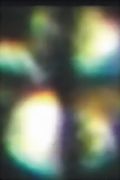 Abstract: For the first time, nannofossils found in the marine stratigraphic unit named
"Patagoniano" which crops out at Cerro Chenque and Cerro Hermitte in southeastern Chubut, Argentina, are documented. They were recovered from pelitic levels
in the lower part of coarsening-upward siliciclastic sedimentary
sequences. The nannofossils are assigned in part to the Discoaster kugleri Zone NN7 (Martini,
1971) and CN5b (Bukry, 1971, 1973) thus allowing correlation of the productive levels with the Serravallian Stage (upper Middle Miocene). Abstract: For the first time, nannofossils found in the marine stratigraphic unit named
"Patagoniano" which crops out at Cerro Chenque and Cerro Hermitte in southeastern Chubut, Argentina, are documented. They were recovered from pelitic levels
in the lower part of coarsening-upward siliciclastic sedimentary
sequences. The nannofossils are assigned in part to the Discoaster kugleri Zone NN7 (Martini,
1971) and CN5b (Bukry, 1971, 1973) thus allowing correlation of the productive levels with the Serravallian Stage (upper Middle Miocene).
|
|
Nota breve 1 [2009]: Nannofósiles del Serravalliano (Mioceno) en Patagonia, Argentina, de Margarita SIMEONI.-
Formato [HTML] o [PDF
689 KB]
Referencia: [CG2009_L01]
Idioma:
|
|
Resumen: Se documenta el primer hallazgo de
nannofósiles en el "Patagoniano", unidad estratigráfica marina
aflorante en Cerro Chenque y Cerro Hermitte, al sudeste de Chubut, Argentina.
Los nannofósiles fueron recuperados en niveles pelíticos inferiores de
diferentes ciclos sedimentarios, grano-crecientes hacia la parte superior,
formados por rocas siliciclásticas. Los nannofósiles pertenecen, en parte, a
la Zona de Discoaster kugleri NN7 (Martini,
1971) and CN5b (Bukry, 1971,
1973) permitiendo la correlación de los niveles
fértiles con el Piso Serravalliano (Mioceno Medio superior).
|
|
Online since March 31, 2009
En línea desde el 31 de Marzo de 2009
|
|
|
|